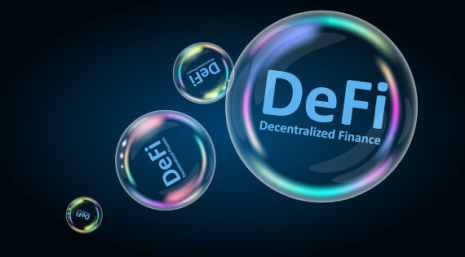Decentralized Finance, or DeFi, has become a buzzword in the world of technology and finance. As more people explore the potential of blockchain and cryptocurrency, DeFi is gaining traction as a revolutionary alternative to traditional financial systems. But what exactly is DeFi, and why is it causing so much excitement? This guide will break down the fundamentals of DeFi, its key features, and the reasons behind its growing popularity.
Understanding DeFi: The Basics
DeFi stands for Decentralized Finance, a term used to describe a new wave of financial services built on blockchain technology. Unlike traditional banking systems, which rely on centralized institutions like banks and governments, DeFi operates through smart contracts—self-executing agreements that automatically enforce the terms of a transaction.
The core idea behind DeFi is to eliminate intermediaries and allow users to interact directly with financial applications. These applications, often referred to as decentralized applications (DApps), run on public blockchains such as Ethereum, allowing for transparency, security, and accessibility.
Key Characteristics of DeFi
- Decentralization: DeFi platforms are not controlled by a single entity. Instead, they operate on a distributed network of nodes, ensuring no central authority can manipulate the system.
- Transparency: All transactions are recorded on a public ledger, making it easy for anyone to verify and audit the system.
- Accessibility: Anyone with an internet connection can access DeFi services, regardless of their location or financial background.
- Interoperability: DeFi protocols are designed to work together, enabling users to combine different services seamlessly.
How Does DeFi Work?
At the heart of DeFi are smart contracts, which are essentially automated programs that execute predefined rules when certain conditions are met. These contracts enable users to lend, borrow, trade, and invest without the need for a middleman.
For example, if you want to borrow money on a DeFi platform, you might deposit a certain amount of cryptocurrency as collateral. The smart contract then automatically issues the loan based on the agreed-upon terms. When you repay the loan, the collateral is released back to you.
This process eliminates the need for banks or other financial institutions, reducing costs and increasing efficiency.
Popular DeFi Applications
Some of the most popular DeFi applications include:
- Lending and Borrowing Platforms: These platforms allow users to earn interest on their crypto assets or take out loans using digital assets as collateral.
- Decentralized Exchanges (DEXs): DEXs enable users to trade cryptocurrencies directly with each other without relying on a centralized exchange.
- Yield Farming and Staking: Users can earn passive income by providing liquidity to DeFi protocols or staking their tokens to support the network.
- Stablecoins: These are digital currencies pegged to real-world assets, such as the US dollar, to reduce volatility.
Why Is DeFi Gaining So Much Attention?
There are several reasons why DeFi is capturing the attention of investors, developers, and everyday users alike.
1. Elimination of Intermediaries
One of the biggest selling points of DeFi is the removal of traditional financial intermediaries. By eliminating banks, brokers, and other third-party entities, DeFi reduces fees and increases the speed of transactions. This makes financial services more accessible and cost-effective for everyone.
2. Financial Inclusion
DeFi has the potential to bring financial services to the unbanked population. According to the World Bank, approximately 1.7 billion adults worldwide remain unbanked. DeFi allows these individuals to access loans, savings accounts, and investment opportunities without needing a traditional bank account.
3. Innovation and Flexibility
DeFi is still in its early stages, but it’s already fostering a lot of innovation. Developers are constantly creating new applications and improving existing ones, leading to a rapidly evolving ecosystem. This flexibility allows users to tailor financial services to their specific needs.
4. Global Reach
Unlike traditional financial systems, which are often limited by geographic boundaries, DeFi is borderless. Users from anywhere in the world can participate in DeFi protocols, making it a truly global financial system.
Risks and Challenges of DeFi
While DeFi offers many benefits, it’s not without its risks. Here are some of the main challenges associated with DeFi:
1. Security Risks
Because DeFi relies on smart contracts, any bugs or vulnerabilities in the code can lead to significant losses. There have been several high-profile hacks and exploits in the DeFi space, resulting in millions of dollars in stolen funds.
2. Regulatory Uncertainty
DeFi operates in a largely unregulated environment, which can be both a blessing and a curse. While this allows for greater freedom and innovation, it also leaves users exposed to potential legal risks. Governments around the world are still figuring out how to regulate DeFi, and this uncertainty could impact its long-term viability.
3. Volatility and Market Risk
Many DeFi platforms are built on volatile assets, such as cryptocurrencies. This means that users can experience significant gains or losses depending on market conditions. The lack of a centralized authority to stabilize prices adds to the risk.
4. User Experience and Education
Despite its potential, DeFi can be complex for newcomers. Understanding how to interact with smart contracts, manage private keys, and navigate decentralized applications requires a certain level of technical knowledge. This can be a barrier for many users who are not familiar with blockchain technology.
The Future of DeFi
As DeFi continues to evolve, it’s likely to play an increasingly important role in the global financial system. With ongoing improvements in security, regulation, and user experience, DeFi has the potential to become a mainstream financial tool.
Experts predict that DeFi could eventually challenge traditional banking systems by offering faster, cheaper, and more transparent financial services. However, achieving this will require continued innovation, collaboration, and a deeper understanding of the risks involved.
Conclusion
DeFi represents a paradigm shift in the way we think about finance. By leveraging blockchain technology, it offers a decentralized, transparent, and accessible alternative to traditional financial systems. While there are still challenges to overcome, the potential benefits of DeFi make it a topic worth watching.
Whether you’re an investor, developer, or simply curious about the future of finance, understanding DeFi is essential. As the ecosystem continues to grow, it’s clear that DeFi is here to stay—and it’s changing the game for everyone involved.












